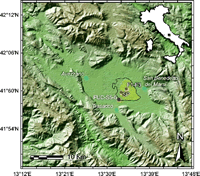Tephra and cryptotephra in a ~ 60,000-year-old lacustrine sequence from the Fucino Basin: new insights into the major explosive events in Italy,
Di Roberto A., A. Smedile, P. Del Carlo, P.M. De Martini, M. Iorio, M. Petrelli, D. Pantosti, S. Pinzi, A. Todrani (2018).
Bulletin of Volcanology, 80/3, 22, https://doi.org/10.1007/s00445-018-1200-x.
Abstract
Two cores were sampled in the Fucino Basin (central Apennines, Italy), which represents an extensional intramountain basin filled by Pliocene to Quaternary continental alluvial and lacustrine deposits. The cores were investigated for tephra content and five visible tephras with thickness ranging from 1 to 8 cm were identified. Six additional cryptotephra were identified during the inspection of significant peaks of the magnetic susceptibility curve. Texture and mineralogy of five tephra and six cryptotephra layers were analyzed by means of scanning electron microscope coupled with energy-dispersive X-ray spectrometry system (SEM-EDS) and geochemical measurements were performed by an electron microprobe (EPMA) equipped with five wavelength-dispersive spectrometers (WDS) and using a laser ablation inductively coupled plasma mass spectrometry (LA-ICP-MS) system on single glass shards. The results allowed us to assign tephra and cryptotephra to ten known volcanic eruptions that occurred over the last ca. 60 ka in the Campanian Province (Phlegrean Fields and Ischia Island), the Alban Hills volcanic complex, and Lipari island. In particular, we recognized the deposits of the Monte Epomeo Green Tuff and the Piroclastiti di Catavola eruptions of Ischia, the pre-Campanian Ignimbrite Tlc, the Campanian Ignimbrite and the Neapolitan Yellow Tuff eruptions of the Phlegrean Fields, the Gabellotto-Fiume Bianco eruption of Lipari, and all the four explosive events belonging to the last cycle of volcanic activity of Albano maar (Albano 4–7). Deposits from five of these identified events (i.e., Piroclastiti di Catavola, Gabellotto-Fiume Bianco, Albano 5 and 6 eruptions, and Campanian Ignimbrite) were previously un-reported in the Fucino basin. These findings add new tephra layers to the list of possible tephrochronologic markers in the region and highlight that a comprehensive tephra record may be constructed when the study of cryptotephra layers is included. Moreover, results provide insights into the most recent volcanic activity of Albano maar, allowing us to date the onset of activity at the maar system at ca. 40 ka and to estimate the ages of all four eruptions that made up this eruptive sequence at ca. 37.5 ka (Albano 5), ca. 36.5 ka (Albano 6) and ca. 36 ka (Albano 7), respectively. Our work extends the known dispersal of several major explosive events, suggesting the intensity and magnitude appraisals, and attended risk scenario’s need to be revised using improved records of distal fall out.
https://link.springer.com/article/10.1007/s00445-018-1200-x#enumeration


